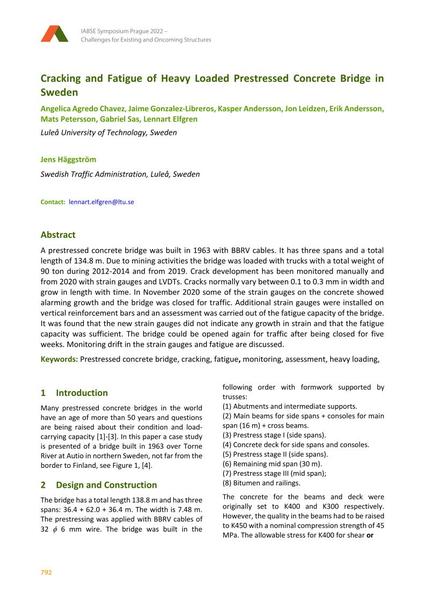Cracking and Fatigue of Heavy Loaded Prestressed Concrete Bridge in Sweden

|
|
|||||||||||
Bibliographic Details
| Author(s): |
Angélica Agredo Chávez
(Luleå University of Technology, Sweden)
Jaime Gonzalez-Libreros (Luleå University of Technology, Sweden) Kasper Andersson (Luleå University of Technology, Sweden) Jon Leidzen (Luleå University of Technology, Sweden) Erik Andersson (Luleå University of Technology, Sweden) Mats Petersson (Luleå University of Technology, Sweden) Gabriel Sas (Luleå University of Technology, Sweden) Lennart Elfgren Jens Häggström (Swedish Traffic Administration, Luleå, Sweden) |
||||
|---|---|---|---|---|---|
| Medium: | conference paper | ||||
| Language(s): | English | ||||
| Conference: | IABSE Symposium: Challenges for Existing and Oncoming Structures, Prague, Czech Republic, 25-27 May 2022 | ||||
| Published in: | IABSE Symposium Prague 2022 | ||||
|
|||||
| Page(s): | 792-799 | ||||
| Total no. of pages: | 8 | ||||
| DOI: | 10.2749/prague.2022.0792 | ||||
| Abstract: |
A prestressed concrete bridge was built in 1963 with BBRV cables. It has three spans and a total length of 134.8 m. Due to mining activities the bridge was loaded with trucks with a total weight of 90 ton during 2012-2014 and from 2019. Crack development has been monitored manually and from 2020 with strain gauges and LVDTs. Cracks normally vary between 0.1 to 0.3 mm in width and grow in length with time. In November 2020 some of the strain gauges on the concrete showed alarming growth and the bridge was closed for traffic. Additional strain gauges were installed on vertical reinforcement bars and an assessment was carried out of the fatigue capacity of the bridge. It was found that the new strain gauges did not indicate any growth in strain and that the fatigue capacity was sufficient. The bridge could be opened again for traffic after being closed for five weeks. Monitoring drift in the strain gauges and fatigue are discussed. |
||||
| Keywords: |
fatigue prestressed concrete bridge cracking assessment monitoring heavy loading
|
||||
| Copyright: | © 2022 International Association for Bridge and Structural Engineering (IABSE) | ||||
| License: | This creative work is copyrighted material and may not be used without explicit approval by the author and/or copyright owner. |
||||
